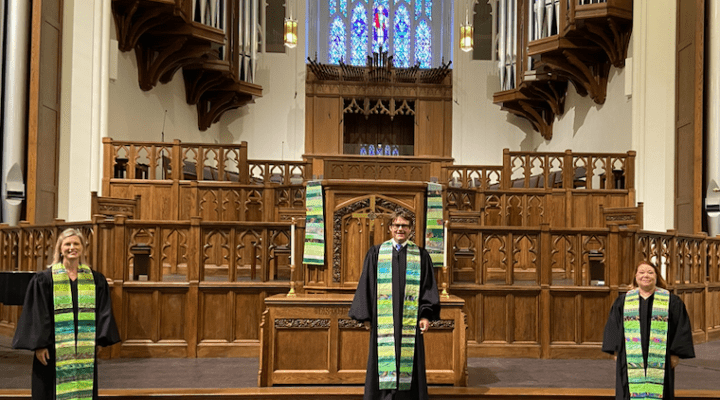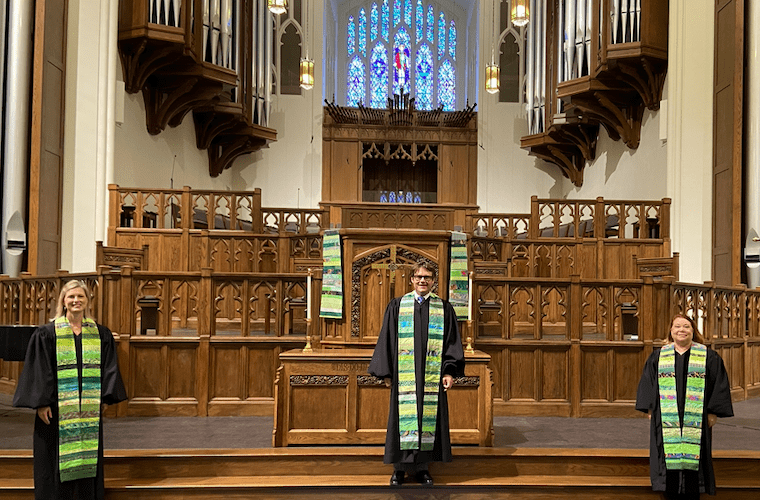When was the last time your church had 200 people show up for a Wednesday night book study?
Before COVID, that never would have happened at Broadway Baptist Church in Fort Worth, Texas, said Senior Pastor Ryon Price. But recently, “my wife and I did a book study on race and racism, and at one of them we had well over 200 for the Wednesday night book study.”
 That kind of dramatically increased attendance has been the pandemic-era experience at Broadway, where the convergence of discipleship and technology is changing more than Sunday morning services.
That kind of dramatically increased attendance has been the pandemic-era experience at Broadway, where the convergence of discipleship and technology is changing more than Sunday morning services.
Even to say that 200 people showed up for a Bible study might be inaccurate, because counting only logins or views does not account for how many people might be present at each viewing point.
“It’s hard to quantify attendance,” said Jenn Nelson, director of communications and membership engagement at Broadway. “In this era, we can’t identify numbers as distinctly as we used to.”
Before the pandemic, it was easy to count people in the pews and to track visitors through the guest cards they filled out and left with ushers or in offering plates.
“It’s much more challenging now. One login can be an individual or a family,” Nelson said.
Furthermore, viewers are choosing to watch Broadway’s worship and other online offerings hours or days after they occurred, she explained. “Some watch it then re-watch it.”
Broadway also makes sermons available to be downloaded separately and listened to numerous times.
That’s why it is difficult to give a number to compare against pre-COVID attendance of up to 450 on Sunday mornings and up to 900 for some holiday concerts, Nelson explained. Still, there are indicators that virtual attendance during the pandemic has much higher. One of those data points is that the congregation’s overall YouTube viewership is 404% higher than before COVID-19.

Jenn Nelson
“The online community of Broadway is expanding,” Nelson said, noting that the virtual format removes old geographic boundaries, allowing the church to reach anyone anywhere with a computer or smartphone.
Many former members have reconnect long distance, and the church has widened its geographical reach during the pandemic, Price added. “We have participants from around the country and in a few small cases around the world.”
In this new era, Broadway has learned to focus more on reach and engagement than the old metrics, Price said. “Instead of looking at viewers or attendees, we have found it better to talk about overall reach, and that is something we have seen to increase at Broadway during the COVID era.”
“Reach” refers to the social media avenues through which the church’s online offerings are accessed, he said. “Engagement” represents efforts to connect and build relationships with those individuals, to keep them involved and coming back.
In this new environment, Sunday school and Wednesday night programs are as important as Sunday services, Price said. “We are not looking at this only through the lens of worship, but through the lens of engagement and how many touchpoints we can create with Broadway. Educational programing, conversations about social justice and worship are not mutually exclusive.”
Nelson says the church has “cast a wide net virtually” because of the pandemic. That has allowed the church, known for its progressive social witness and liturgical worship style, to upgrade its technological and programming capabilities to ensure a high-quality, engaging presentation, Price added.
“Like many churches during this time, Broadway has invented new ways to do old rituals important to church life.”
Like many churches during this time, Broadway has invented new ways to do old rituals important to church life, Price said. “When people have joined the church, they have joined virtually. We will do a short video interview with a new member instead of them coming forward. We had one family join in their car; those are things you did not see prior to COVID.”
This will create a lasting change in how Broadway conducts its ministries even after the pandemic, he predicted. “We are still going to be thinking much more broadly than we formerly did when it comes to engagement and possibilities online.”
Broadway’s experience mirrors national trends reported by Pew Research. An August survey found that “one-third of U.S. adults have watched religious services online or on television in the past month, and a little over half of them — or 18% of all adults — say they began doing this for the first time during the coronavirus pandemic.”
The study also found that nine out of 10 Americans who attended online worship said they were either “very” or “somewhat” satisfied with the experience.
And a LifeWay Research study released in October reported worshipers were not returning to in-person worship in pre-pandemic numbers despite the increasing availability of such services. “Most pastors say their congregation has less than 70% of their pre-COVID crowds,” LifeWay reported.


